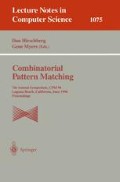Abstract
Inferring the consensus of a set of different evolutionary trees for a given species set is a well-studied problem, for which several different models have been proposed. In this paper, we propose a new optimization problem for consensus tree construction, which we call the asymmetric median tree, or AMT. Our main theoretical result is the equivalence between the asymmetric median tree problem on k trees and the maximum independent set (MIS) problem on k-colored graphs. Although the problem is NP-hard for three or more trees, we have polynomial time algorithms to construct the AMT for two trees and an approximation algorithm for three or more trees. We define a measure of phylogenetic resolution and show that our algorithms (both exact and approximate) produce consensus trees that on every input are at least as resolved as the standard models (strict consensus and majority tree) in use. Finally, we show that the AMT combines desirable features of many of the standard consensus tree models in use.
This work was performed under U.S. Department of Energy contract number DE-AC04-76AL85000.
Research partly supported by an NSF National Young Investigator Award under contract ccr-9457800 and from an NSF grant in Linguistics.
Preview
Unable to display preview. Download preview PDF.
References
Amir, A., and Keselman, D. Maximum agreement subtree in a set of evolutionary trees — metrics and efficient algorithms, Proceedings, FOCS '94.
Barthelemy, J.P., and McMorris, F.R. (1986), The median procedure for n-trees, Journal of Classification (3), pp. 329–334.
M. Bellare and M. Sudan, “Improved non-approximability results”, Proceedings of the Twenty-Sixth Annual ACM Symposium on Theory of Computing, (Montreal), ACM, pp. 184–193.
David Bryant, “Hunting for binary trees in binary character sets: efficient algorithms for extraction, enumeration, and optimization”, Research Report #124, Department of Mathematics and Statistics, Canterbury University, Christchurch, New Zealand, April 1995.
Day, W.H.E. (1985), Optimal algorithms for comparing trees with labelled leaves, Journal of Classification 2, pp. 7–28.
Day, W.H.E., and Sankoff, D. (1986), Computational complexity of inferring phylogenies by compatibility, Systematic Zoology, 35, pp. 224–229.
G.F. Estabrook, C.S. Johnson, Jr., and F.R. McMorris (1976), A mathematical foundation for the analysis of cladistic character compatibility, Math. Biosci. 29, pp. 181–187.
Estabrook, G.F., and McMorris, F.R. (1980), When is one estimate of evolutionary relationships a refinement of another?, J. Math. Biosci. 10, pp. 327–373.
M. Farach, T. Przytycka, and M. Thorup, On the agreement of many trees, Information Processing Letters, to appear.
M. Farach and M. Thorup, Sparse Dynamic Programming for Evolutionary Tree Comparison, SIAM J. on Computing.
Farach, M. and Thorup, M. (1994), Optimal evolutionary tree comparisons by sparse dynamic programming, Proceedings, FOCS '94.
Garey, M.R. and Johnson, D.S., Computers and Intractability: A Guide to the Theory of N P-Completeness, W.H. Freeman and Company, NY, 1979.
Gusfield, D. (1991), Efficient algorithms for inferring evolutionary trees, Networks 21, pp. 19–28.
Hopcroft, J., and Karp, R.M. (1975), An O(n2.5) algorithm for maximum matching in bipartite graphs, SIAM J. on Computing, 1975, pp. 225–231.
D. S. Johnson, “A catalog of complexity classes”, in Algorithms and Complexity, volume A of Handbook of Theoretical Computer Science, Elsevier science publishing company, Amsterdam, 1990, pp. 67–161.
Kao, Ming. Tree contractions and evolutionary trees, submitted for publication (1995).
McMorris, F.R. and Steel, M. (1994), The complexity of the median procedure for binary trees. Proceedings of the 4th Conference of the International Federation of Classification Societies, Paris 1993, to be published in the series “Studies in Classification, Data Analysis, and Knowledge Organization” by Springer Verlag.
Page, R. D. M. (1993), Genes, Organisms, and Areas: The Problem of Multiple Lineages, Systematic Biology, 42(1), 77–84.
Page, R. D. M. (1993), Reconciled Trees and Cladistic Analysis of Historical Associations Between Genes, Organisms, and Areas, manuscript.
N. Saitou and M. Nei, The neighbor-joining method: a new method for reconstructing evolutionary trees, Mol. Biol. Evol. 4: 406–25, 1987.
Steel, M.A., and Warnow, T.J. (1993), Kaikoura tree theorems: Computing the maximum agreement subtree, Information Processing Letters 48, pp. 72–82.
Wareham, H. T. (1985) ”An Efficient Algorithm for Computing Ml Consensus Trees”, Honors Dissertation, Department of Computer Science, Memorial University of Newfoundland, St. John's, Newfoundland.
Warnow, T.J. (1994), Tree compatibility and inferring evolutionary history, Journal of Algorithms, 16, pp. 388–407.
Author information
Authors and Affiliations
Editor information
Rights and permissions
Copyright information
© 1996 Springer-Verlag Berlin Heidelberg
About this paper
Cite this paper
Phillips, C., Warnow, T.J. (1996). The asymmetric median tree — A new model for building consensus trees. In: Hirschberg, D., Myers, G. (eds) Combinatorial Pattern Matching. CPM 1996. Lecture Notes in Computer Science, vol 1075. Springer, Berlin, Heidelberg. https://doi.org/10.1007/3-540-61258-0_18
Download citation
DOI: https://doi.org/10.1007/3-540-61258-0_18
Published:
Publisher Name: Springer, Berlin, Heidelberg
Print ISBN: 978-3-540-61258-2
Online ISBN: 978-3-540-68390-2
eBook Packages: Springer Book Archive

